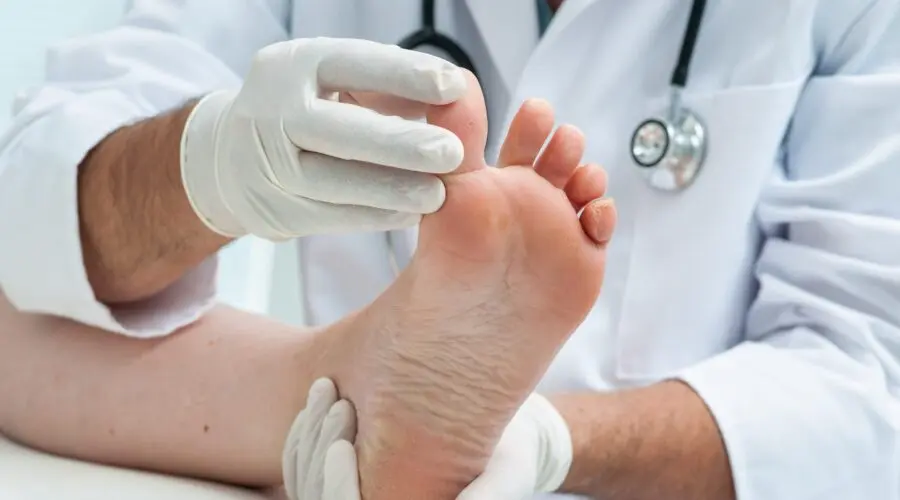
Trichophyton fungi are what causes an athlete’s foot – a dermatological infection. This foot fungus thrives in the spaces between the toes, where moisture tends to build up.
The fungus that causes athlete’s foot is very infectious and may be found in locations like locker rooms and public swimming pools.
Athlete’s foot is a difficult condition to treat, and it frequently recurs. If left untreated, it can extend to the sole of the foot, resulting in bacterial infection and problems.
It can spread to the nails in advanced stages, causing them to stiffen and discolor. Athlete’s foot can also produce discomfort in other parts of the body, such as the groin or hands.
Let’s look at how to spot this problem and what you can do to avoid it.
Athlete’s foot symptoms
Athlete’s foot is a skin infection that mostly affects the toes. Tinea pedis symptoms are generally more unpleasant than painful, but they should never be overlooked.
An athlete’s foot infection can cause the following symptoms:
- Itching between the toes
- Redness
- Persistent foul odor
- Desquamation (cracking and peeling skin)
- Appearance of blisters
- Skin thickening on the soles of the feet
The infection might extend to the sole of the foot in more severe instances. It also leads to the formation of cracks, which can lead to bacterial infections.
People who are at a higher risk of developing plantar bacterial infections are:
- Senior citizens
- Those who have an immune deficiency disease such as HIV
- People with liver inflammation
- People who are receiving chemotherapy
- Diabetic patients: The body’s capacity to protect itself is harmed by a lack of blood flow and excessive sugar levels.
Athlete’s foot causes and risk factors
Like all dermatophytosis, an athlete’s foot is caused by a fungus. Because molds thrive in moist environments, athletes’ feet are particularly at risk, hence the name “athlete’s foot”. This plantar infection is also extremely infectious. As a result, it can manifest in a wide range of patients.
Athlete’s foot is most commonly caused by the following factors:
- Excessive sweating on the soles of the feet
- Moisture build-up between the toes
- Wearing shoes that are too tight or poorly ventilated
- Poor foot hygiene
- Walking barefoot in a contaminated area (public pool, sauna, locker rooms or shared showers)
- Sharing contaminated personal items such as socks or towels
Athlete’s foot prevention
Athlete’s foot, unlike some other foot infections, is easily treated. On the other hand, if left untreated, it might develop into more difficult-to-cure issues. If it remains unattended, nail fungus is one of the diseases that might develop out of it.
Athlete’s foot is a highly contagious infection. As a result, the infected person must take care to prevent infecting others.
To avoid contamination and the spread of athlete’s foot, adopt the following precautions as a general rule:
- Bathing sandals should be worn in damp locations where there are a lot of people, such as the pool, sauna, or locker rooms.
- Avoid wearing shoes that are excessively tight since they do not allow air to circulate and retain moisture. Mold is more likely to grow in certain environments.
- Instead of synthetic materials, opt for cotton or wool socks. Because synthetic fabrics tend to retain moisture, they should be avoided.
- Wash your feet with soap and water on a daily basis.
- Dry the foot and the space between the toes properly with a clean towel and let them air dry.
- Avoid wearing the same pair of shoes over and over again or for an extended period of time.
- In rainy conditions, go for open-toed shoes.
- Use just your own sporting equipment, shoes, and socks.
Your feet, as you can see, need to breathe! If these measures aren’t enough, the podiatrist can make a diagnosis and prescribe the necessary treatment.
Overcoming athlete’s foot
Athlete’s foot is usually simple to recognize and cure. Creams, sprays, and powders sold at pharmacies are typically successful in halting the spread of the disease.
Medication is an option if the infection is causing severe pain or spreading uncontrolled.
During a visit with a podiatrist, a precise diagnosis will be made. A basic visual check is usually adequate. He or she may have to collect a skin sample if this is not the case.
Following that, the podiatrist will be able to recommend different antimycotic medicines, both oral and topical.
If the nail is infected, the podiatrist may recommend laser therapy to remove the fungus from beneath it.
Athlete’s foot has a high propensity to recur on its own. If this is the case, it is critical to seek the assistance of a medical expert. He or she will be happy to give excellent pain relief solutions so that you may continue your normal activities.
PiedReseau – Learn more
Are you curious about fungus-related foot illnesses like athlete’s foot? We give updates on this issue on a regular basis!
Even if the PiedReseau website is full of useful information, nothing beats a face-to-face visit with a podiatrist.
Take care of your feet, they’re precious!